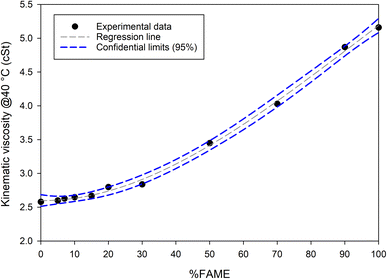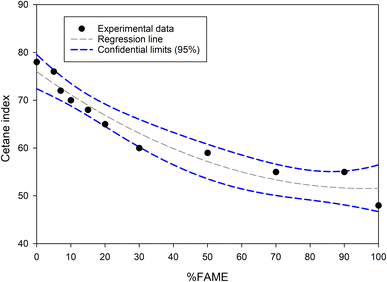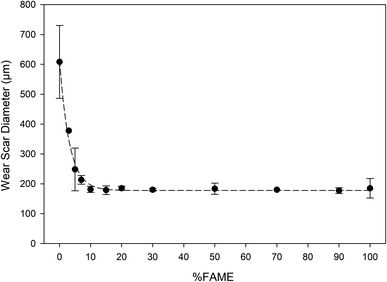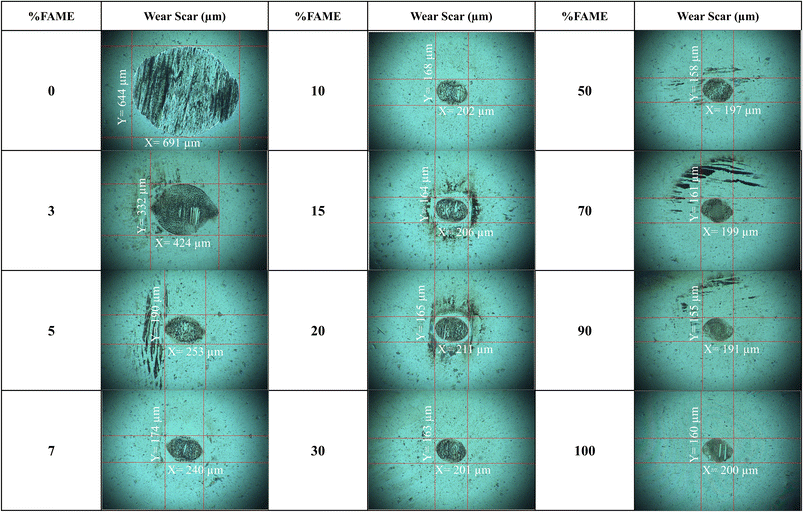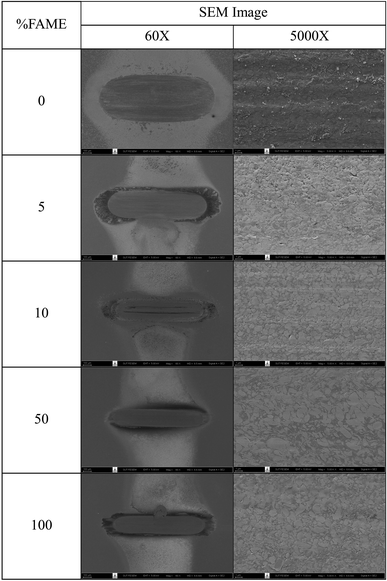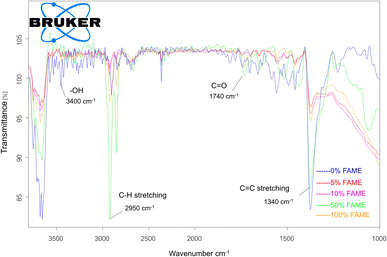 Open Access Article
Open Access ArticleComprehensive analysis of properties of green diesel enhanced by fatty acid methyl esters†
Sarunporn Sriprathuma,
Atthaphon Maneedaeng*a,
Niti Klinkaewb and
Ekarong Sukjit c
c
aSchool of Chemical Engineering, Institute of Engineering, Suranaree University of Technology, Nakhon Ratchasima, 30000 Thailand. E-mail: atthaphon@sut.ac.th
bInstitute of Research and Development, Suranaree University of Technology, Nakhon Ratchasima, 30000 Thailand
cSchool of Mechanical Engineering, Institute of Engineering, Suranaree University of Technology, Nakhon Ratchasima, 30000 Thailand
First published on 27th October 2023
Abstract
This study systematically investigates the lubricating properties of bio-hydrogenated diesel (BHD), a synthetic diesel produced through biomass hydrogenation of vegetable oil. Despite having similar chemical properties to petroleum diesel, BHD has poor lubricating properties due to the removal of sulfur and oxygenated compounds during the hydrogenation process, which could damage the engine. To address this issue, fatty acid methyl esters (FAME) was added as an additive to BHD to enhance its fuel and lubricating properties. FAME is a polar molecule with good lubricating properties that adsorb on the surface to protect against wear. The study found that adding as little as 5% FAME significantly improved the lubricating properties of BHD. The wear scar diameter (WSD) decreased from 609 μm to 249 μm, and the average film was 94% with an average coefficient of friction of 0.138 by only 5% FAME addition investigated by High Frequency Reciprocating Rig with ISO 12156-1: 2018. This shows that blending FAME with BHD could reduce engine wear and improve its lubricating properties. Disc samples were analyzed using a Scanning Electron Microscope (SEM), OLS5100 3D laser microscopy, and Fourier Transform Infrared Microscopy (FTIR) to examine the worn surface both physically and chemically. An increase in the percentage of FAME addition to BHD resulted in a smoother worn surface, exhibiting reduced delamination and debris compared to pure BHD. This effect was attributed to the protective film formed by FAME. The study highlights the potential of FAME as an additive to enhance the lubricating properties of BHD and reduce engine wear.
1. Introduction
Air pollution presents a pressing challenge that jeopardizes human health and environmental well-being. Particulate matter with a diameter less than 2.5 microns (PM2.5) poses a grave threat as it can infiltrate the respiratory system, causing respiratory ailments, allergies, and even lung cancer.1 A significant contributor to air pollution is the incomplete combustion of fossil fuels, leading to the emission of carbon monoxide due to engine and fuel injector wear.2 Additionally, industrial activities exacerbate the issue by releasing pollutants into the atmosphere. The ramifications of air pollution extend beyond human health, with far-reaching impacts on global warming stemming from greenhouse gas emissions. Consequently, urgent action is imperative to combat air pollution. Transitioning to renewable and alternative energy sources is a pivotal step in reducing emissions.Bio-hydrogenated diesel (BHD) emerges as a promising synthetic green diesel, offering an environmentally friendly alternative energy solution.3 Derived from vegetable oils and fats through hydrogenation, BHD undergoes a catalytic transformation that yields a molecular structure akin to conventional diesel fuel, encompassing long-chain hydrocarbons (C14H30–C16H34). The advantages of BHD are manifold, including a higher cetane number, lower sulfur content, and cleaner energy profile, resulting in a potential reduction of up to 9% in nitrogen oxide (NOx) emissions and 32% in particulate matter (PM) emissions.4,5 Notwithstanding its merits, BHD exhibits room for enhancement in specific aspects, particularly its lubrication properties. The lubrication properties of BHD do not meet the standards set by national and international regulations, as indicated by a limited wear scar diameter of 460 μm. Inadequate lubrication can have detrimental effects on engine wear. Recent advancements demonstrate the efficacy of blending ultra-low sulfur diesel with fatty acid methyl esters (FAME) derived from rapeseed to enhance the lubrication of Swedish diesel fuel MK1.6 A similar approach involving BHD blending has the potential to enhance vehicle performance and curtail emissions; however, this blending is constrained by certain properties that necessitate refinement, including cold flow properties and lubricity.7 While tribological theories have explored the lubricity attributes of fuels derived from plastic pyrolysis oil and waste cooking biodiesel when blended with diesel-palm biodiesel,8 limited research has specifically targeted the augmentation of BHD's lubricating attributes.7,9–12
Hence, the drive for improvement in the bio-hydrogenated diesel (BHD) blend's lubricating properties and overall fuel characteristics remains pivotal. Moreover, tribological investigations into synthetic fuels hold promise for mitigating environmental concerns, extending the lifespan of diesel engines, and curbing the aging and wear of fuel injectors. This study is dedicated to advancing the fuel and lubricating attributes of this eco-friendly liquid fuel by harnessing the potential of fatty acid methyl esters (FAME) as an additive. FAME, a biodiesel synthesized via sustainable technologies, is derived from the transesterification process. Widely employed in conjunction with commercial diesel fuel, known as B7 and B10,13 FAME augmentation has demonstrated the capability to enhance diesel fuel's lubricating characteristics, leading to reduced friction and wear scars. The polar head and extended fatty acid chain structure of FAME molecules confer favorable mixed and boundary lubrication properties, even at low concentrations.10,14 This research seeks to methodically investigate the fuel characteristics and lubrication efficacy of synthetic fuel blended with FAME. The focal point of this study is to address the necessity for enhancing the fuel and lubricating properties of eco-friendly liquid fuel, fostering improved performance and diminished environmental impact.
The primary novelty of this study lies in the systematic exploration of the lubricating and fuel properties of synthetic fuel blends containing FAME. Unlike previous studies, which have mainly focused on broad property trends and general lubricity improvements, the research aims to delineate the intricate relationship between FAME content and lubrication efficiency within the context of BHD blends. By investigating a full range of FAME concentrations and their impact on fuel and lubrication properties, the intention is to unveil the optimal conditions that yield enhanced lubrication while addressing potential challenges such as viscosity and cetane index properties. Furthermore, this analysis expands beyond common properties by scrutinizing lesser-studied aspects, such as specific gravity. This comprehensive approach enriches understanding of the intricate interplay between FAME concentration, fuel characteristics, and lubrication performance.
2. Materials and methods
2.1 Chemicals
The commercial specification of bio-hydrogenated diesel derived hydrogenation of palm oil (BHD) was obtained from Verasuwan Co., Ltd, Thailand. The industrial-grade biodiesel, composed of Fatty Acid Methyl Esters (FAME) obtained from transesterification of palm oil and a mixture of partially recycled cooking oils, was procured from Biosynergy Co., Ltd, Thailand. Both biofuels were characterized by Gas Chromatography (GC) Technique to examine the variation of hydrocarbon molecules. The qualitative analysis of hydrocarbon compounds was tabulated in Table 1 in accordance with the GC/MS full scan shown in ESI† section. They have been utilized for a large-scale industry and transportation. Acetone (AR grade) with purity of 99.5% was purchased from RCl Labscan. Sodium Bromide (Analytical grade) with purity of 99.5% was purchased from QReC.| Compounds | Peak area | |
|---|---|---|
| % in BHD | % in FAME | |
| C8:0 | 0.42 | 0.0 |
| C10:0 | 1.08 | 0.0 |
| C11:0 | 4.69 | 0.0 |
| C12:0 | 8.16 | 0.25 |
| C13:0 | 5.95 | 0.0 |
| C14:0 | 12.71 | 0.97 |
| C15:0 | 25.01 | 0.06 |
| C16:0 | 40.70 | 41.61 |
| C16:1 | 0.0 | 0.14 |
| C18:0 | 0.0 | 5.66 |
| C18:1 | 0.0 | 39.45 |
| C18:2 | 0.0 | 11.07 |
| C20:1 | 0.0 | 0.71 |
| C21:0 | 0.0 | 0.09 |
| Aromatics | 1.3 | 0.0 |
| 100.0 | 100.0 | |
2.2 Fuel properties
The investigation firstly focused on examining the fuel properties of green diesel blended with varying concentrations of FAME between 0–100% by volume using standard procedures. The kinematic viscosity analysis was carried out using ASTM D445 at 40 °C in a glass capillary and temperature control water bath. Similarly, the specific gravity was analysed using ASTM D1298 at 15.6 °C in a density API and specific gravity with temperature-controlled water bath, while the calculated cetane index was estimated using the Nomograph method with ASTM D976. The fuel properties assessed in this study underwent triple measurements, aligning with ASTM standards that adhere to the regulations established by the Department of Energy Business, Ministry of Energy, Thailand i.e., the limitation of chemical and physical properties of diesel fuel specified accordingly with the nation regulation as revised in June 2020.2.3 Lubrication properties
The lubrication properties of synthetic diesel fuel were examined using High-Frequency Reciprocating Rig (HFRR), PCS Instruments. Friction coefficient, film percentage, and wear scar diameter were obtained for further investigation of lubrication mechanism. In the HFRR cabinet, an upper specimen holder with a ball and weight loading, and a lower specimen holder with a disc, fuel sample, and temperature probe were installed. The ball and disc are made from stainless steel 6 mm in diameter for a ball and 3 mm thick, 10 mm in diameter for a disc. BHD was blended by FAME ranged between 0–100% by volume with testing conditions in accordance with ISO 12156-1: 2018. The standard testing condition was a fluid volume of 2 ml, fuel temperature at 60 °C, frequency of 50 Hz, stroke length of 1 mm, test mass of 200 g, and test duration of 75 min. The temperature and humidity in the cabinet were controlled according to laboratory ambient using sodium bromide saturated solution in accordance with the testing standard15 which is a temperature of 20–26 °C and relative humidity of 48–58%. Upon conducting the test, the ball was subjected to a cleaning process in accordance with the standard procedure. Subsequently, a measurement of the wear scar on the surface of the ball was taken along the X and Y dimensions utilizing a metallurgical microscope that had a magnification of 100×.The disc was also taken to measure the wear area, depth, and volume by LEXT OLS 5100 (Olympus, Tokyo, Japan) and surface roughness around the worn zone. The worn surface on disc was further examined by scanning electron microscopy (SEM) AURIGA (Carl-Zeiss, Jena, Germany), JSM-7800F (JEOL Ltd, Tokyo, Japan) to illustrate the abrasive mechanism. The deposit formation around the worn surface was chemically examined using FTIR microscope with an MCT detector. The disc specimen was cooled with liquid nitrogen over the measurement range from 4000 to 400 cm−1 with an IR microscope (Hyperion 3000, Bruker). The microscope was connected to a software-controlled microscope stage and placed in a specially designed box that was purged by dry air. The measurements were performed in the mapping mode, using an aperture size of 8 × 3 μm with a spectral resolution of 4 cm−1, with 64 scans co-added.
3. Results and discussion
The percentage of area under chromatogram peaks of hydrocarbon profiles in BHD and fatty acid compositions in FAME is presented in Table 1, indicating that hexadecane (C16), pentadecane (C15), and tetradecane (C14) are the predominant paraffin constituents of BHD in consecutive order. BHD, akin to conventional diesel derived from petroleum, is composed of lengthy hydrocarbon chains. Upon examination of BHD's hydrocarbon compound, it is observed that saturated hydrocarbon molecules demonstrate a propensity for efficient combustion. Alkanes tend to produce fewer emissions of particulate matter and sulfur oxides than petroleum diesel, which can help improve air quality and reduce the environmental impact of combustion.16 Nevertheless, their lubricating properties exhibit suboptimal performance due to the hydrogenation of double bonds within unsaturated triglyceride molecules during catalytic reactions. Additionally, thermochemical conversion processes lead to the reduction of long-chain hydrocarbons such as decarbonylation and decarboxylation, resulting in the formation of shorter-chain hydrocarbons, ultimately contributing to the production of alkanes.17 However, FAME does not solely comprise palmitic acid (C16:0), but additionally exhibits substantial levels of oleic acid (C18:1) and linoleic acid (C18:2). The occurrence of unsaturated hydrocarbons is indicative of their pronounced influence on the reduction of friction and lubrication improvement in a range of biofuel blends.11,18–20The study shows the enhancement of fuel properties such as the kinematic viscosity, specific gravity, and cetane index of BHD fuel by incorporating FAME in varying proportions, ranging from 0% to 100% as tabulated in Table 2 and shown in Fig. 1–3. Based on the test results shown in Fig. 1, the viscosity characteristics of BHD fuel improved significantly as the proportion of biodiesel increased from 0% to 70%. The kinematic viscosity values remained within the acceptable range specified by the Department of Energy Business, Ministry of Energy, Thailand, which mandates a maximum viscosity limit of 4.1 cSt for diesel fuel. It is noteworthy that the study demonstrated the efficacy of adding FAME in enhancing the viscosity properties of BHD fuel, while conforming to the regulatory standards. The viscosity of FAME can impact the performance of diesel engines when used as BHD. Higher viscosity can lead to increased fuel consumption, engine deposits, and emissions, as well as reduced fuel atomization and spray penetration. Studies have shown that the viscosity of FAME can be influenced by various factors, including the type of feedstock, the degree of unsaturation, and the level of impurities.21 In 2018, Chen et al. investigated the effect of FAME viscosity on the fuel spray and combustion characteristics of a common rail diesel engine. Their results showed that higher FAME viscosity can lead to reduced fuel atomization and spray penetration, as well as increased combustion duration and particulate emissions.22
| % FAME | Kinematic viscosity at 40 °C (cSt) | Specific gravity at 15.6 °C | Cetane index |
|---|---|---|---|
| 0 | 2.58 | 0.770 | 78 |
| 5 | 2.60 | 0.775 | 76 |
| 7 | 2.63 | 0.784 | 72 |
| 10 | 2.65 | 0.788 | 70 |
| 15 | 2.67 | 0.793 | 68 |
| 20 | 2.80 | 0.801 | 65 |
| 30 | 2.84 | 0.815 | 60 |
| 50 | 3.45 | 0.825 | 59 |
| 70 | 4.03 | 0.845 | 55 |
| 90 | 4.87 | 0.850 | 55 |
| 100 | 5.16 | 0.875 | 48 |
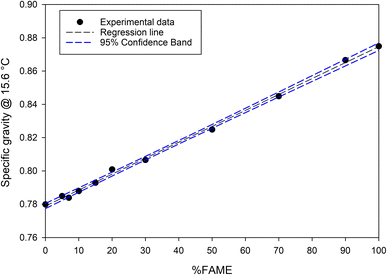 | ||
| Fig. 2 Variation of specific gravity at 15.6 °C of BHD with different concentration of FAME addition. | ||
There is a relationship between the viscosity and lubrication properties, viscosity plays a crucial role in lubrication, as it is a measure of a fluid's resistance to flow. In general, fluids with lower viscosity tend to have better lubrication properties as they can easily flow between two surfaces, reducing friction and wear.23 FAME, which is fatty acid methyl esters, has a higher viscosity than BHD, which can impact its lubricating properties.12,24 However, the presence of polar compounds in FAME, such as carboxylic group of fatty acids, can enhance its lubricating properties, even with the higher viscosity. BHD, on the other hand, has poor lubricating properties due to the removal of sulfur and oxygenated compounds during the hydrogenation process. Incorporating FAME into BHD can enhance the fuel's lubricating properties by creating a protective film layer that diminishes wear and friction. This film layer is discussed in detail in the subsequent section. FAME's innate lubricating properties can contribute to this effect, resulting in improved lubrication characteristics for the blended biofuel.
Consider Fig. 2, which depicts the investigation of alterations in specific gravity attributes upon the addition of biodiesel, ranging from 0% to 100%, to BHD fuel. The experimental results indicate that up to a 90% addition of FAME, the specific gravity attributes remain within the prescribed limit. The standard for specific gravity of diesel fuel, as determined by the Department of Energy Business, Ministry of Energy, Thailand, dictates that it should be in a range of 0.81–0.87 for 30–90% FAME. The specific gravity of FAME blended with BHD can impact the fuel properties and performance of the fuel. It is generally recognized that the specific gravity of FAME is slightly higher than that of petroleum diesel. As a result, this disparity can impact engine power output and fuel consumption. However, blending FAME with BHD can increase the specific gravity of the blended biofuel as shown in Fig. 2, and could improve its performance. Specific gravity is a measure of the density of a substance relative to the density of water at a specific temperature. The specific gravity of FAME can vary depending on the type of feedstock used and the degree of unsaturation. When blended with BHD, the specific gravity of the blended fuel can be increased to meet the desired fuel properties and engine performance requirements.
Several studies have explored the impact of specific gravity on the emission and performance of biodiesel blends. Elevating the specific gravity of FAME blends can lead to better engine performance and reduced emissions, particularly under higher engine loads.25 Additionally, alternative research suggests that optimizing the manufacturing process or integrating additives can enhance the specific gravity and overall performance of FAME blends.26,27
Refer to Fig. 3, which presents the investigation of changes in calculated cetane index characteristics upon the incorporation of FAME in varying proportions, ranging from 0% to 100%, into BHD fuel. The findings indicate that up to a 90% addition of FAME, the cetane index attributes remain within the stipulated range. As per the standard value in Thailand, the cetane index of diesel fuel should surpass 50. The cetane number of the resulting blend is lower than that of BHD alone. This is because the lower cetane number of FAME has a diluting effect on the overall blend. The degree of reduction in cetane index depends on the proportion of FAME in the blend and the cetane number of the specific FAME used. When blending BHD with FAME, it's common to see a reduction in cetane index. Cetane index is a measure of the combustion quality of diesel fuels, and higher cetane index values generally indicate better combustion characteristics. The reduction in cetane index is due to the lower cetane number of FAME compared to BHD. Cetane number is a related but slightly different measure than cetane index, with higher values indicating better combustion quality. BHD typically has a higher cetane number than FAME due to its molecular structure and production process.
According to a study by Cendeia et al. in 2009, the blending of FAME with diesel fuel can result in a decrease in the cetane number of the blend, which in turn affects engine performance and emissions.28 Similarly, Kim et al. in 2014 studied the effects of blending different biodiesel feedstocks on the properties of diesel–biodiesel blends and their effects on engine performance, combustion, and emissions. In contrast to the findings of this study, it has been determined that the incorporation of FAME into conventional diesel fuel can lead to a gradual elevation in the cetane number, thereby exerting a beneficial influence on both engine performance and emissions.29 In practical terms, an increase in cetane index can result in decreased emissions, increased engine performance, and lower levels of engine deposits. To mitigate these effects, it's important to carefully consider the blend ratio and the specific FAME used in the blend. Additionally, engine calibration adjustments may be necessary to optimize combustion performance.
The calculated cetane index of BHD is a measure of its ignition quality and is based on the fuel's chemical composition, specifically the amount and type of hydrocarbons present. BHD is typically produced from feedstocks with a higher degree of saturation, such as vegetable oils or animal fats, which results in a fuel with a higher cetane number compared to standard diesel derived from petroleum.30,31 A higher cetane number indicates that the fuel will ignite more readily and burn more completely in the combustion chamber, resulting in improved engine performance and reduced emissions. Additionally, the hydrogenation process used to produce BHD can also increase the cetane number by saturating unsaturated hydrocarbons, resulting in a fuel with a more uniform and predictable combustion behavior.32 Fig. 4 and 5 exhibits an investigation of the lubricating properties of BHD with different FAME concentration addition between 0 to 100% using HFRR with ISO 12156-1: 2018. The evaluation was obtained through the wear scar diameter (WSD), which was measured in micrometers by using a microscope on the ball, the friction coefficient (CoF), and the film percentage. Each sample was subjected to triple measurement. However, if the difference in the values of WSD exceeded ±20 μm, a fourth test was performed to verify the repeatability of the results. The mean values of WSD were then calculated and plotted in Fig. 4. Experimentally, it was observed that there is a positive correlation between the concentration of FAME and the lubricity, as indicated by the reduction in friction and wear. This phenomenon can be attributed to the presence of aliphatic fatty acids in FAME, particularly oleic and linoleic acids, which possess the ability to enhance lubrication properties. These acids promote the development of lubrication films, which regulate the friction and wear between contacting surfaces. The adsorption of oxygen-containing compounds and a mixture of several fatty acids in methyl esters on the rubbing surface further contributes to the reduction in friction and improvement in the film stability and thickness of the boundary lubrication regime.
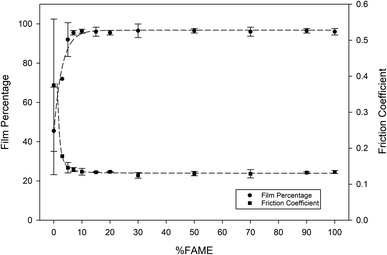 | ||
| Fig. 5 Variation of percentage of film and friction coefficient of BHD with different concentration of FAME addition. | ||
Despite the numerous benefits of utilizing BHD over traditional diesel, such as higher cetane number, reduced sulfur content, and decreased NOx and PM emissions,33 inadequate lubrication can result in adverse effects on engine wear. Experimentally, the wear scar diameter (WSD) of pure BHD was approximately 609 μm. However, when blended with 5% FAME, the WSD reduced to 249 μm and continued to gradually decrease until reaching stability at a 10% FAME addition, with a WSD of 178–185 μm. The study reveals that an increase in FAME concentration leads to an increase in the proportion of the tribofilm covering the surface under frictional conditions. The application of protective films on the surface results in a reduction of thermal energy in reciprocating contact, ultimately enhancing lubricity.34–36 It is plausible that the carboxylic acid moiety serves as the fundamental building block for the formation of lubricity-enhancing films. In addition, the presence of trace components in the FAME, such as free fatty acids, monoglycerides, and diglycerides, may also contribute to improving the lubricity of blended fuels.37
According to Fig. 5, a decrease in CoF was observed with an increase in FAME concentration. The average range of CoF was found to be between 0.121–0.178, which suggests the presence of a boundary lubrication mechanism.8,38 In contrast, the CoF of pure BHD was found to be 0.452. The film percentage, which indicates the formation of a protective layer on the metal surface to prevent wear, was observed to be between 96–98% for the range of FAME concentrations studied. Careful consideration is necessary when quantifying the film percentage utilizing electrical contact potential (ECR) due to the potential for misleading outcomes caused by dust or wear on the disc's surface. It is crucial to acknowledge these factors and take appropriate measures to ensure the accuracy of the ECR measurement.39,40 Microscopic analysis of wear scars on ball bearings for blended biofuels, as shown in Fig. 6, indicates that the inclusion of 3–5% FAME in BHD blend results in a significant reduction in wear scar diameter as compared to that observed with pure BHD. Further, it is observed that the wear scar diameter remains stable at concentrations of 10% FAME and above.
These results highlight the potential of biofuel blends in mitigating the adverse effects of wear and tear in machinery and equipment. It is imperative to conduct further research in this area to fully understand the mechanism behind this observation and optimize the use of biofuels in industrial applications. When analysing the stability of thin film creation in lubrication processes, several illustrative systems are depicted in Fig. 7. These systems display a notable increase in the speed of thin film formation, reaching over 95% formation in 10–15 minutes. This can be attributed to the chemical properties of unsaturated fatty acids present in FAME, which adhere to the surface of stainless-steel specimens and create a layer that resembles a film under the area of friction. It is worth noting that the concentration of FAME has a significant impact on the process of film formation, with higher concentrations resulting in a faster and more effective stabilization of the film. Therefore, an increase in the percentage of FAME addition leads to an accelerated process of film formation and improved film stability. The analysis of the worn surface of engine components is a crucial tool for understanding the mechanisms of wear and degradation in diesel engines. According to Swain et al. in 2021, the surface morphology and topography of worn surfaces can identify the types of wear that have occurred, such as abrasive wear, adhesive wear, or fatigue wear.41
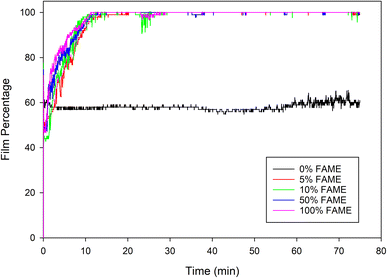 | ||
| Fig. 7 Evolution of film formation under the lubrication process of BHD with different concentration of FAME addition. | ||
Additionally, analysing the chemical composition of the worn surface can provide insight into the mechanisms of deposit formation and corrosion that can lead to engine damage.42 In the context of FAME blending with BHD in diesel engines, examining the worn surface of engine components with different percentages of FAME can provide valuable information on the impact of FAME blending on engine wear and degradation. By comparing the surface morphology and chemical composition of the worn surfaces, we can identify any differences in wear patterns or deposit formation that may be attributed to the use of FAME blends. This information can be useful in developing strategies to minimize engine wear and improve engine performance and longevity.40
Fig. 8 portrays wear volume, wear area, and wear depths on worn surfaces, whereby wear depth measurements were acquired by identifying the minimum position on the wear scar. The outcomes indicated a reduction in wear depth proportional to the increase in FAME concentration. The reduction was marginal until a stable level was achieved at 10% FAME. The outcomes align with the findings in Fig. 4, which indicate a positive correlation between wear scar diameter and FAME concentration. Thus, the incorporation of FAME into BHD's composition contributes to the enhancement of its lubricating property. Fig. 9 presents comprehensive data on the wear depth and 3D profiles of the worn surface on the disc, obtained using the LEXT OLS 5100 imaging system. Specifically, the wear depth values for a concentration of 0% FAME, 10% FAME, 50% FAME, and 100% FAME were measured at 10.389 μm, 1.683 μm, 1.661 μm, and 1.474 μm respectively, under conditions of reciprocated rubbing of the ball against the disc. Notably, the 3D profile analysis of the worn surface also revealed a decrease in the depth of wear scars with an increase in FAME concentration. This phenomenon can be attributed to the significant protection provided by the tribofilm, assisted by the presence of unsaturated molecules in FAME, on the stainless-steel contact surface. The experimental findings in this study are consistent with the outcomes of Ruggiero et al., who carried out a comprehensive investigation on the tribological properties of fatty acid methyl esters (FAME).11 Sulek et al. reported data on surface roughness, depth of wear and 2D profiles of the worn surface, as well as the impact of FAME concentration on the wear depth.43 Their study showed that the unsaturated molecules in FAME produce a tribofilm that offers considerable protection on the contact surface of stainless steel, leading to a reduction in friction and wear. Fig. 10 presents the scanning electron microscopy (SEM) images of the worn surface on the disc. SEM images indicate the presence of abrasive wear, which is a common phenomenon during the HFRR test, resulting from the intermingling of hard particles between the ball and the disc, as well as debris formation.32 The SEM images portray the full worn surface at 60× and 5000× magnification. The addition of FAME leads to an improvement in lubricating properties, thus decreasing the area of worn surface in comparison to the worn surface of the disc under 0% FAME (pure BHD).
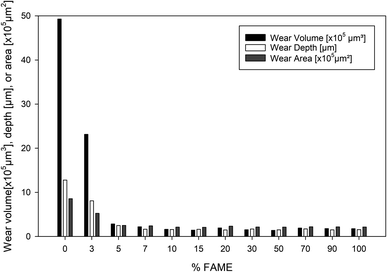 | ||
| Fig. 8 Variation of wear volume, wear depth, and wear area with of the blended fuels of FAME in BHD. | ||
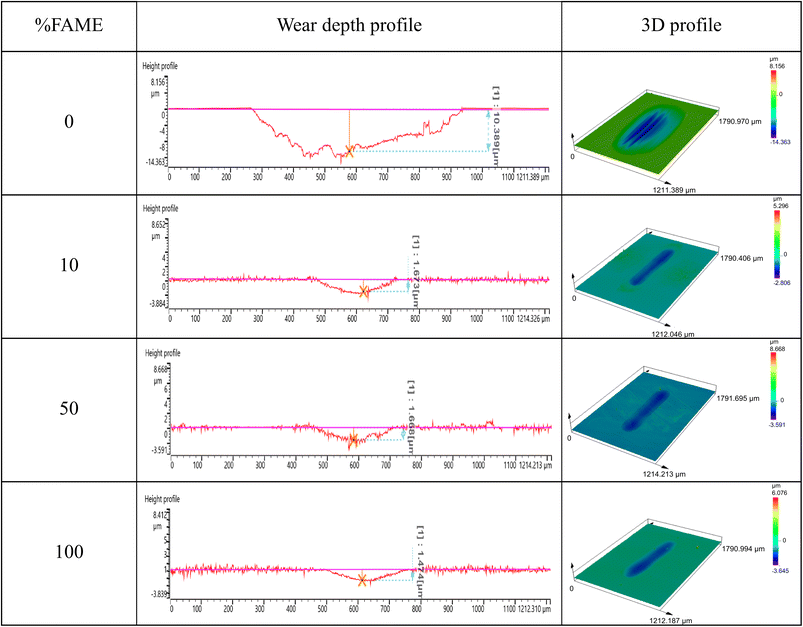 | ||
| Fig. 9 Selected depiction of depth and 3D profiles of worn surface on the disc for the blended fuels of FAME in BHD. | ||
Significantly, an increase in the percentage of FAME resulted in the appearance of black residues around the worn surface of the disc. Further, an energy-dispersive spectrometer (EDS) analysis reveals the formation of waxy carbon on the disc, which could be attributed to heat generation during the test.44,45 In the worn surface of the disc under 0% FAME, wear debris was clearly discovered. An increase in the percentage of FAME added to bio-hydrogenated diesel has been found to result in a worn surface that appears smoother and shows reduced delamination and debris when compared to the worn surface of pure BHD. However, with the increase in the FAME concentration, the worn surface's smoothness significantly improves. The FT-IR spectra depicted in Fig. 11 shows the results of examining the chemical compounds present on and around the worn surface of a blended fuels with varying concentrations of FAME in BHD. The spectra show several peaks representing various chemical bonds and functional groups. The broad peak at around 3400 cm−1 corresponds to the stretching vibrations of the O–H bonds present in the carboxylic acids in the FAME. The peak at around 2950 cm−1 is attributed to the C–H stretching vibrations of the methyl and methylene groups in both the FAME and the BHD.
This suggests a decrease in the amount of alkyl groups in the sample, possibly due to the presence of FAME. This observation is consistent with the findings of previous studies, which have also reported a decrease in the intensity of this peak with an increase in the percentage of FAME in biodiesel blends.46,47 The peak at around 1740 cm−1 is associated with the stretching vibrations of the C![[double bond, length as m-dash]](https://www.rsc.org/images/entities/char_e001.gif) O bond in the ester groups present in the FAME.
O bond in the ester groups present in the FAME.
The intensity of the peak at around 1740 cm−1 increases with increasing FAME concentration, indicating a higher concentration of ester groups in the sample. This increase in ester concentration may enhance the lubricating properties of the blend due to the polar nature of the ester groups. This is consistent with the presence of more ester groups in the sample, as FAME is a type of esters. Previous studies have also reported a similar trend in the FT-IR spectra of biodiesel blends, which is in agreement with this observation.46,47 Additionally, the appearance of peaks at around 1600 cm−1 and 1340 cm−1, which are attributed to the C![[double bond, length as m-dash]](https://www.rsc.org/images/entities/char_e001.gif) C stretching vibrations and the bending vibrations of the CH2 groups, respectively, suggests the presence of unsaturated fatty acids in the FAME. The formation of deposit compounds from FAME blending with BHD during the lubrication process in diesel engines is a common issue that can negatively impact engine performance and longevity. Hydrocarbon deposits can accumulate on the worn surfaces of engine components, which can interfere with proper lubrication and increase friction between moving parts. This can lead to increased wear and tear on the engine, reducing its efficiency and potentially causing damage over time. Several studies have investigated the impact of FAME blending with BHD on deposit formation in diesel engines. One study found that the use of biodiesel blends containing FAME resulted in higher deposit formation on the engine components compared to pure diesel fuel.48 Another study showed that the presence of FAME in the fuel resulted in increased deposit formation on the piston crown and cylinder head of the engine.49 To minimize the formation of deposits in diesel engines, several strategies have been proposed. One approach is to use high-quality fuel and lubricants that are specifically designed to reduce deposit formation. Another approach is to implement regular maintenance and cleaning of the engine components to prevent the build-up of deposit compounds. Additionally, some studies have suggested the use of fuel additives, such as detergents and dispersants, to reduce the formation of deposits in the engine.50
C stretching vibrations and the bending vibrations of the CH2 groups, respectively, suggests the presence of unsaturated fatty acids in the FAME. The formation of deposit compounds from FAME blending with BHD during the lubrication process in diesel engines is a common issue that can negatively impact engine performance and longevity. Hydrocarbon deposits can accumulate on the worn surfaces of engine components, which can interfere with proper lubrication and increase friction between moving parts. This can lead to increased wear and tear on the engine, reducing its efficiency and potentially causing damage over time. Several studies have investigated the impact of FAME blending with BHD on deposit formation in diesel engines. One study found that the use of biodiesel blends containing FAME resulted in higher deposit formation on the engine components compared to pure diesel fuel.48 Another study showed that the presence of FAME in the fuel resulted in increased deposit formation on the piston crown and cylinder head of the engine.49 To minimize the formation of deposits in diesel engines, several strategies have been proposed. One approach is to use high-quality fuel and lubricants that are specifically designed to reduce deposit formation. Another approach is to implement regular maintenance and cleaning of the engine components to prevent the build-up of deposit compounds. Additionally, some studies have suggested the use of fuel additives, such as detergents and dispersants, to reduce the formation of deposits in the engine.50
4. Conclusions
In conclusion, this study demonstrates that the addition of fatty acid methyl esters (FAME) to bio-hydrogenated diesel (BHD) can improve its fuel properties. BHD mainly consists of paraffin hydrocarbons, while FAME contains unsaturated hydrocarbons that enhance lubrication and reduce friction. Mixing FAME into BHD can improve lubricating properties and specific gravity but reduces cetane index because of the diluting effect. FAME concentration positively correlates with lubricity and reduces friction and wear, with aliphatic fatty acids and trace components such as monoglycerides and diglycerides contributing to film formation and enhanced lubricity. Biofuel blends can mitigate adverse wear effects in machinery, with unsaturated fatty acids in FAME accelerating the formation of thin films in lubrication processes.Analysing worn surfaces with different FAME percentages can inform strategies for minimizing engine wear and improving performance, with FAME incorporation into BHD enhancing its lubricating properties and leading to reduced wear depth and smoother worn surfaces. The study identifies the presence of abrasive wear and black residues, with carbon formation and wear debris reduced at higher FAME concentrations. However, increasing FAME concentration leads to higher deposit formation on worn surfaces. Further research is needed to optimize the use of blended biofuels in industrial applications. The forthcoming research endeavors will aim to establish a correlation between the black residue that forms on a worn surface as a result of oxidation reactions, and the deposition of material within engine components.
Author contributions
The study was conceptualized by AM and ES, who were instrumental in securing the necessary financial resources to undertake the research. Additionally, they contributed to the editorial process to enhance the manuscript's quality. SS conducted tribology experiments using advanced equipment and provided insightful commentary on the initial manuscript draft, enriching the quality of the final product. NK contributed to the testing of fuel properties and offered valuable insights and commentary on the relevant sections of the manuscript.Conflicts of interest
There are no conflicts to declare.Acknowledgements
This work was financially supported by Office of National Higher Education Science Research and Innovation Policy Council, and Thailand Science Research and Innovation (TSRI), through Program Management Unit for Competitiveness (PMU-C), PTT Exploration and Production Public Co., Ltd., Cherdchai Corporation Co., Ltd., Polawat Engine Co., Ltd., and Verasuwan Co., Ltd., grant no. C04F660060. This work was also supported by (i) Suranaree University of Technology (SUT), (ii) Thailand Science Research and Innovation (TSRI), and (iii) National Science, Research and Innovation Fund (NSRF) through Fundamental Fund, grant no. 160346. The co-author, SS, also wishes to express gratitude to Suranaree University of Technology for generously providing a grant in support of her pursuit of a Master's degree.References
- E. Long and C. Carlsten, Part. Fibre Toxicol., 2022, 19, 11 CrossRef PubMed.
- H. Masjuki, A. M. Zaki and S. M. Sapuan, J. Am. Oil Chem. Soc., 1993, 70, 1021–1025 CrossRef CAS.
- R. Caprotti, T. Tang, N. Ishibe, R. In-ochanon, C. Tipdecho and S. Silapakampeerapap, SAE [Tech. Pap.], 2011, 2011–01–1953 Search PubMed.
- T. Hartikka, M. Kuronen and U. Kiiski, SAE [Tech. Pap.], 2012, 9, 2012–01–1585 Search PubMed.
- H. Aatola, M. Larmi, T. Sarjovaara and S. Mikkonen, SAE Int. J. Engines, 2009, 1, 1251–1262 CrossRef.
- E. Sukjit and K. D. Dearn, Wear, 2011, 271, 1772–1777 CrossRef CAS.
- M. Lapuerta, M. Villajos, J. R. Agudelo and A. L. Boehman, Fuel Process. Technol., 2011, 92, 2406–2411 CrossRef CAS.
- M. S. N. Awang, N. W. M. Zulkifli, M. M. Abbas, S. A. Zulkifli, M. A. Kalam, M. N. A. M. Yusoff, W. M. A. W. Daud and M. H. Ahmad, Alexandria Eng. J., 2022, 61, 7221–7231 CrossRef.
- M. Happonen, J. Heikkilä, P. Aakko-Saksa, T. Murtonen, K. Lehto, A. Rostedi, T. Sarjovaara, M. Larmi, J. Keskinen and A. Virtanen, Fuel, 2013, 103, 380–386 CrossRef CAS.
- M. A. Hazrat, M. G. Rasul and M. M. K. Khan, Energy Procedia, 2015, 75, 111–117 CrossRef CAS.
- A. Ruggiero, R. D'Amato, M. Merola, P. Valašek and M. Müller, Tribol. Int., 2017, 109, 529–540 CrossRef CAS.
- N. A. Fathurrahman, A. S. Auzani, R. Zaelani, R. Anggarani, L. Aisyah, Maymuchar and C. S. Wibowo, Lubricants, 2023, 11, 176 CrossRef CAS.
- S. Nupueng, P. Oosterveer and A. P. J. Mol, Energy Sci. Eng., 2018, 6, 643–657 CrossRef.
- Z. Liu, F. Li, J. Shen and h. Wang, Energy Sustainable Dev., 2019, 52, 33–39 CrossRef.
- EN ISO 12156-1, Diesel fuel: assessment of lubricity using the high frequency reciprocating rig (HFRR)-Part 1: test method, Belgium, European Committee for Standardization, Brussels, 2018 Search PubMed.
- J. M. Bergthorson and M. J. Thomson, Renewable Sustainable Energy Rev., 2015, 42, 1393–1417 CrossRef CAS.
- N. Hongloi, P. Prapainainar and C. Prapainainar, Mol. Catal., 2021, 523, 111696 CrossRef.
- N. A. Zainal, N. W. M. Zulkifli, M. Gulzar and H. H. Masjuki, Renewable Sustainable Energy Rev., 2018, 82, 80–102 CrossRef CAS.
- N. A. Masripan, M. A. Salim, G. Omar, M. R. Mansor, A. M. Saad, N. A. Hamid, M. I. Syaki and F. Dai, Int. J. Nanoelectron. Mater., 2020, 13, 161–176 Search PubMed.
- R. Gusain, A. Khan and O. P. Khatri, J. Mol. Liq., 2020, 301, 112322 CrossRef CAS.
- A. Q. Mairizal, S. Awad, C. R. Priadi, D. M. Hartono, S. S. Moersidik, M. Tazerout and Y. Yves, Renewable Energy, 2020, 145, 375–381 CrossRef CAS.
- P.-C. Chen, W.-C. Wang, W. L. Roberts and T. Fang, Fuel, 2013, 103, 850–861 CrossRef CAS.
- J. Milano, A. H. Shamsuddin, A. S. Silitonga, A. H. Sebayang, M. A. Siregar, H. H. Masjuki, M. A. Pulungan, S. R. Chia and M. F. M. A. Zamri, Energy Rep., 2022, 8, 1578–1590 CrossRef.
- M. Tongroon, A. Suebwong, M. Kananont, J. Aunchaisri and N. Chollacoop, Renewable Energy, 2017, 113, 660–668 CrossRef CAS.
- N. Usta, E. Öztürk, Ö. Can, E. S. Çonkur, S. Nas, A. H. Çon, A. Ç. Can and M. Topcu, Energy Convers. Manage., 2005, 46, 741–755 CrossRef CAS.
- R. O. Dunn, Trans. ASABE, 2011, 54, 571–579 CAS.
- H. Fang, S. Whitacre, E. Yamaguchi and M. Boons, SAE [Tech. Pap.], 2007, 2017–01–4141 Search PubMed.
- R. A. Candeia, M. C. D. Silva, J. R. Carvalho Filho, M. G. A. Brasilino, T. C. Bicudo, I. M. G. Santos and A. G. Souza, Fuel, 2009, 88, 738–743 CrossRef CAS.
- D. Kim, S. Kim, S. Oh and S.-Y. No, Fuel, 2014, 125, 36–43 CrossRef CAS.
- S. Jaroonjitsathian, C. Tipdecho, P. Sukajit, N. Namthirach and S. Suppatvech, SAE [Tech. Pap.], 2013, 1, 2013–01–0070 Search PubMed.
- S. Loganathan, in Innovations in Fuel Economy and Sustainable Road Transport, 2011, pp. 97–107 Search PubMed.
- E. Sukjit, M. Tongroon, N. Chollacoop, Y. Yoshimura, P. Poapongsakorn, M. Lapuerta and K. D. Dearn, Wear, 2019, 426–427, 813–818 CrossRef CAS.
- K. Sugiyama, I. Goto, K. Kitano, K. Mogi and M. Honkanen, SAE Int. J. Fuels Lubr., 2012, 5, 205–217 CrossRef CAS.
- M. A. Fazal, A. S. M. A. Haseeb and H. H. Masjuki, Energy Convers. Manage., 2013, 67, 251–256 CrossRef CAS.
- H. H. Masjuki and M. A. Maleque, Wear, 1996, 198, 293–299 CrossRef CAS.
- U. S. Choi, B. G. Ahn, O. K. Kwon and Y. J. Chun, Tribol. Int., 1997, 30, 677–683 CrossRef CAS.
- K. Wadumesthrige, M. Ara, S. O. Salley and K. Y. Simon Ng, Energy Fuels, 2009, 23, 2229–2234 CrossRef CAS.
- Y. Singh, A. Singla, A. K. Singh and A. K. Upadhyay, Biofuels, 2018, 9, 523–530 CrossRef CAS.
- S. M. Campen, Imperial College London for the degree of Doctor of Philosophy, 2012 Search PubMed.
- F. T. Hong, E. Singh and S. M. Sarathy, Fuel, 2021, 302, 121135 CrossRef CAS.
- B. Swain, S. K. Bhuyan, R. Behera, S. S. Mohapatra and A. Behera, in Tribology in Materials and Manufacturing - Wear, Friction and Lubrication 2021 Search PubMed.
- A. M. Liaquat, H. H. Masjuki, M. A. Kalam, M. A. Fazal, A. F. Khan, H. Fayaz and M. Varman, Applied Energy, 2013, 111, 882–893 CrossRef CAS.
- M. W. Sulek, A. Kulczycki and A. Malysa, Wear, 2010, 268, 104–108 CrossRef CAS.
- E. Sukjit, K. Dearn and A. Tsolakis, SAE Int. J. Fuels Lubr., 2012, 5, 154–162 CrossRef CAS.
- E. Sukjit, J. M. Herreros, K. D. Dearn, R. García-Contreras and A. Tsolakis, Energy, 2012, 42 Search PubMed.
- A. Oyerinde and E. Bello, Br. J. Appl. Sci. Technol., 2016, 13, 1–14 CrossRef CAS.
- H. Feld and N. Oberender, SAE Int. J. Fuels Lubr., 2016, 9, 717–724 CrossRef CAS.
- M. Alves-Fortunato, E. Ayoub, K. Bacha, A. Mouret and C. Dalmazzone, Fuel, 2020, 268, 117074 CrossRef CAS.
- A. T. Hoang and A. T. Le, Energy Sources, Part A, 2018, 41, 584–599 CrossRef.
- G. Żak, L. Ziemiański, Z. Stępień and M. Wojtasik, Fuel, 2014, 122, 12–20 CrossRef.
Footnote |
| † Electronic supplementary information (ESI) available. See DOI: https://doi.org/10.1039/d3ra06492a |
| This journal is © The Royal Society of Chemistry 2023 |

